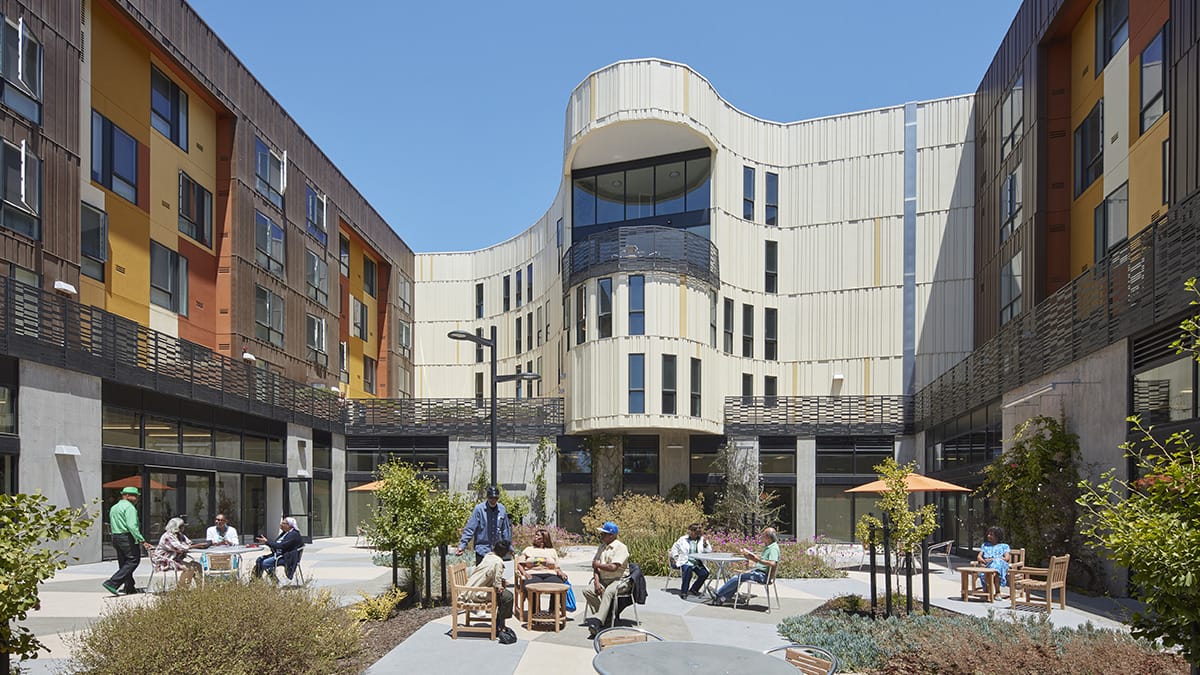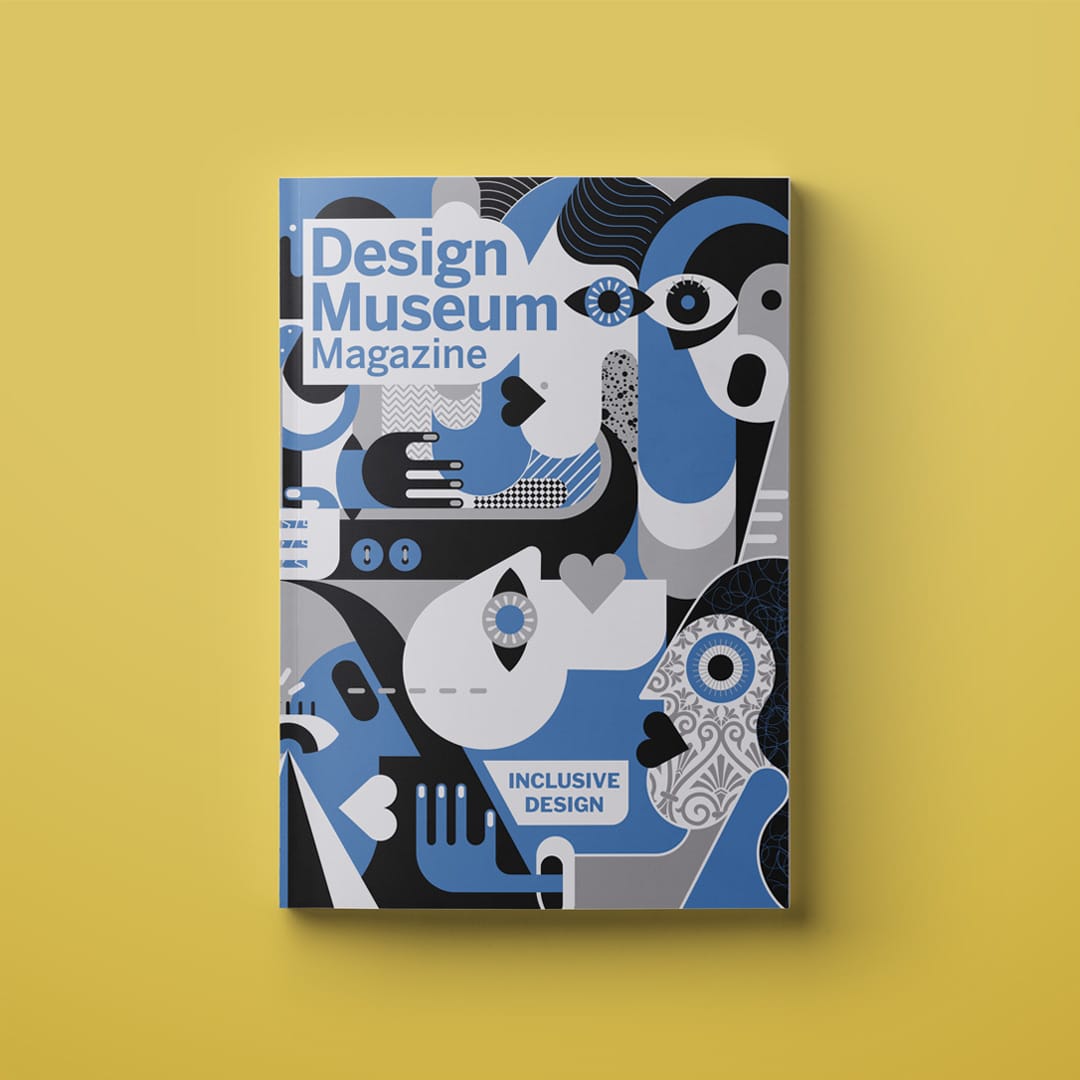Accessibility & Inclusion in Housing Design

Flexible, biophilic courtyard shared by George W. Davis Senior Housing residents and the attached neighborhood-serving community center, framed by Afrocentric design elements. (Bruce Damonte)
By Anne Riggs
In the United States, “accessible” has become a legally defined term denoting compliance with minimum required standards for programs, places, and products to be usable by people with disabilities. These standards include federal civil rights legislation such as the well known Americans with Disabilities Act of 1990 (ADA) and the 1968 Fair Housing Act, as well as various state and local building codes. The ADA and related laws have been critical in guaranteeing basic civil rights for people with disabilities. While compliance with these minimum standards does ensure a valuable baseline of access, the reality is that it does not result in truly usable and enjoyable environments.
This accessibility legislation uses a precise, narrow legal definition of what it means for an environment to be considered accessible and is based on anthropometric research and metrics initially conducted in the mid-20th century. As designers creating spaces for people under these guidelines, we can fall short of our ethical obligations to design with empathy, compassion, and awareness of how unconscious bias and/or ableism—the limitations of our personal experience—may negatively impact our designs.
In the design of homes, it is especially important to provide environments that support residents to carry out their daily needs with dignity and joy. Even new homes that comply with minimum requirements may not provide a level of access that truly acknowledges residents’ right to live full lives in their homes. For example, in ADA-compliant homes with more than one bathroom, only one fully accessible bathroom is required. In the other bathrooms, designers often fail to provide space for a wheelchair to enter the room and turn around. For privately funded homes that are only subject to the less restrictive Fair Housing Act, a wheelchair turning space in bathrooms is not even required. Imagine designing a custom home that did not allow your client to physically enter every room!
All aspects of the built environment—from stair height and door width to the design of doorknobs and handles— have evolved over time to accommodate a specific range of human sizes and abilities. As designers, we make conscious decisions about these and other items in all of our work that determine who we include and who we exclude.
Even communities that provide a high level of accessibility to individual homes can still contribute to the segregation and exclusion of individuals with disabilities. If all of the required accessible units and common spaces are on the ground floor, the ADA does not require an elevator to allow access to the upper stories of an apartment building. This excludes residents who can’t climb stairs from enjoying equal opportunities for relationships with their neighbors and community. It also means that guests with limited mobility may be unable to visit family and friends living in upper level units.
The concept of universal design, coined by architect and accessibility advocate Ronald L Mace in the 1970s, seeks to end segregation based on disability, and encourages environments that exceed the minimum requirements of the ADA and incorporate enhanced accessibility features as a core component of their design philosophy. Universal design promotes seven broad principles that designers should follow to create environments that allow for equity, flexibility, simplicity, and ease of use for people with a broad range of abilities.
The term “inclusive design” is often—I believe inaccurately— used interchangeably with “‘universal design.” As an affordable housing architect serving residents who have often experienced systemic injustice and trauma, I see inclusive design as a tool to integrate design for disability as a core component of an ethical commitment to justice, equity, diversity and inclusion. Inclusive design includes a critical shift from a prescriptive approach to a consensus-based approach, valuing and centering the voices of those most affected by the work. It benefits not only individuals with a wide range of abilities, but also extends those benefits to everyone, including people of different ages, family status, race/ethnicity, and socioeconomic backgrounds. Inclusive design incorporates concerns beyond physical access, recognizing the need for environments that are not only accessible, but also welcoming, dignified, and reflective of occupants’ identities and needs.
Through the inclusive design process, we invite and lift up the voices of people of all different abilities and perspectives, whose experiences and expertise are most relevant to those our buildings will ultimately serve. My favorite tool in this approach is the Inclusive Design Focus Group, a structured interaction following guidelines created by The Kelsey, a non-profit disability advocacy organization based in San Francisco. These simple but powerful workshops invite project-specific participants, such as local service and community organizations and neighbors—including individuals with diverse abilities—to an open-ended discussion of priorities and considerations that they believe are most important to a successful, inclusive community. Each workshop I’ve participated in has been a rewarding experience that successfully identified considerations specific to the project at hand, and also helped me become a better, more responsive designer moving forward on future projects.
The beauty of adopting inclusive design practices is the opportunity to learn something new with each conversation. It’s impossible to simply write a checklist of building features that can be incorporated to complete an inclusive design, you have to engage with the specifics of your project. That said, I can share some illustrative examples of what I have learned through this practice. The ADA requires a certain number of parking spaces to be accessible and for a certain percentage of those to be a wider van-accessible stall that allows wheelchair accessible vehicles to load and unload. Unfortunately, there is no special designation for vans that reserves the larger spaces for folks who need them. People who need to unload a wheelchair may be completely unable to access a facility if a van-accessible parking space is unavailable. These spaces are only 4 feet wider than a standard accessible stall, so I now recommend finding the space to make more stalls van-accessible whenever possible. Also, many individuals with disabilities use paratransit services, which need a temporary loading area to park while the driver collects passengers and assists them in loading. These vehicles may need to pick up more than one client, so providing a comfortable, safe waiting area with a bench near the loading zone is helpful while passengers wait. Accessibility regulations prioritize basic facility access for people with mobility, hearing, and vision impairments, which is, of course, critically important. However, the spectrum of ability is much more diverse and intersectional than what is reflected in these codes. Features that people might not associate with disability access can actually provide benefits to everyone, including people with diverse abilities. For example, countertops and floors that are easy to clean—without gaps or textures— make life a great deal easier for a wide range of people. They are great for families with pets or children; people caring for service and emotional support animals; people with increased personal hygiene or toileting needs; and neurodiverse individuals who benefit psychologically from an environment that is both easy to clean and that appears clean and orderly. As another example, intuitive and clear space planning and signage designed to support blind and low-vision users also makes it easier for language learners and neurodiverse guests to navigate in the environment.
As an architect working for a firm that designs hundreds of homes per year, my goal is to advocate for inclusive design practices in all our work. David Baker Architects has joined The Kelsey as a Committed Firm dedicated to promoting inclusive design for housing. We are currently undertaking several pilot projects utilizing The Kelsey’s new Housing Design Standards for Accessibility and Inclusion, developed through extensive work with a stakeholder advisory group. I encourage all designers working on housing, and anyone interested in learning more about inclusive design, to visit thekelsey.org for more information and resources.
